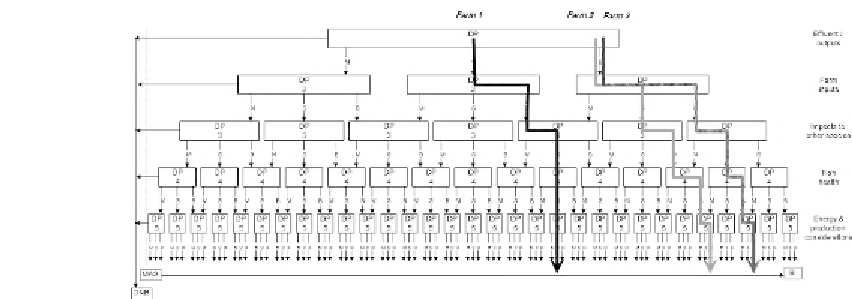Environmental Engineering Reference
In-Depth Information
Figure 16.3
The aquaculture decision-ranking tool. Each farm is assessed within each decision point
(DP) as utilising best (B), suitable (S) or minimal (M) practices. Other notation is as for Figure 16.2.
An example of a BA outcome for a specific DP for a fish farm would be if there
were no significant chemical or therapeutant inputs.
Within each DP, there is also a 'minimal acceptable standard' (MAS). If a stock is
heavily overfished, displays patterns of heavy overfishing or severe depletion, and
does not have a rebuilding plan or shows evidence of rebuilding, then it would fall
below the MAS and be ranked as 'do not buy' (DNB). Provided that a given fishery
unit or farm meets the MAS in each DP, then it would continue to be evaluated
within individual DP-specific decision sub-matrices (not shown here) to assess its
performance.
Once an outcome for each DP is determined, it is marked on the graphical
depiction of the relevant decision-ranking tool (Figures 16.2 and 16.3) as an arrow
leading down one of the BA, S, M or DNB outcome paths. Each of these paths leads
to the next DP that is then evaluated independently. As decisions are determined
for each DP, the ranking path is created and the arrow moves towards the base of
the decision-ranking tool and the final outcome.
While the categories of BA, S and M are qualitative and rather broad, it is possible
through the analysis of benchmark data to distinguish between operations at a
finer scale as needed. For example, if two fishery units have similar characteristics
and fall out on the same decision path, it would be possible to revisit each unit
and tease apart each DP in more detail to examine any differences between the
fishery units. In the case of farmed species, there is a greater opportunity to collect
quantitative data to distinguish between two operations, making it possible to rely
on specific outcome values to differentiate between seafood sources. The ranking on
the decision tool may not change, but these subtle differences can be incorporated
into the recommendation forwarded to the corporate partner.
Due to the hierarchical nature of the decision-ranking tool, each DP does not
have the same importance in determining the best practices of a farm or fishery,
which is why they are addressed in their specified order (Table 16.1). DPs that are








Search WWH ::

Custom Search